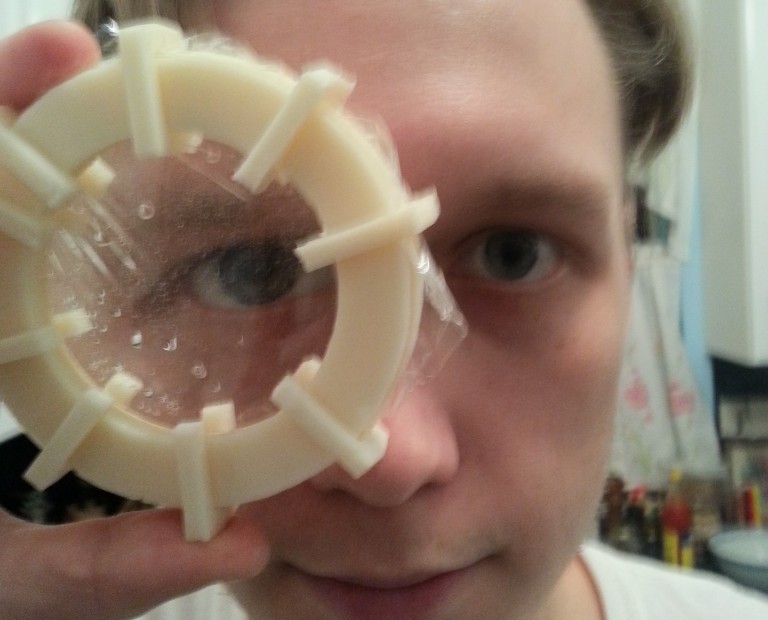[Christopher] is really going the distance with his liquid-filled 3D printed lens project. The idea is to create a bladder out of two pieces of clear plastic. It can then be filled with liquid at a variable level of pressure to curve the plastic and create an adjustable lens. He was inspired by the TED talk (which we swear we already covered but couldn’t find the post) given by [Josh Silver] on adjustable eyeglass lenses.
Don’t miss the video after the break. [Christopher] shows off the assembly process for one lens. Two 3D printed frames are pressure fit together to hold one piece of plastic wrap. Two of those assemblies are then joined with JB weld and some 3D printed clips that help to hold it. A piece of shrink tubing is used as a hose to connect a syringe to the bladder. By filling the lens assembly with water he’s able to adjust how it refracts light.
















In order to help with the wrinkled/imperfections surface after the tightening you could use a blower dryer/hot air gun on the cellophane .
Really neat idea though! Congrats.
A neat idea indeed, but still waiting for someone to print something like that at home: http://www.disneyresearch.com/project/printed-optics/
http://hackaday.com/2013/03/06/everything-you-need-to-build-a-light-cured-resin-3d-printer
Plus polishing.
How is it possible to create a liquid-filled lens that doesn’t suffer from astigmatism? A liquid-filled lens, with plastic film surfaces, oriented in a in vertical plane, is going to be fatter near the bottom than the top. This is because of the effects of gravity on the fluid and the fact that the surface films are flexible. Modulating pressure doesn’t correct this.
A liquid lens in horizontal plane will suffer similar effects, though the effects will at least be radially symmetrical.
Perhaps a measured speed of spin would solve that problem to a degree..
Is it possible to achieve a similar effect as this using air rather than water? I’d think that air would suffer less from gravity (although it’d introduce a whole host of other problems)…
Probably not. A lens element needs to be constructed of a material with a different index of refraction than the surrounding media (e.g. air). An air filled system would not be a simple lens, but rather a two element system with each element consisting of a (likely) uniformly thick, curved element. Since the plastic itself would have a different index of refraction than air, there would be some lensing….so with careful design it might be possible to make something work (possibly if you design the membrane to be a Fresnel lens such that inflating alters the structure of the Fresnel elements), but it wouldn’t be as simple as altering the focal length of the lens.
To get around the gravity problem, I think you would need to choose a material that did not stretch very easily and use a higher pressure. If you can bring the pressure gradient and wall forces up high enough, you can minimize the relative contribution by gravity and minimize the distortion. You would also probably want to index match the fluid and membrane.
+1 to Polaczek’s suggestion, often used to take up extra slack in electrostatic speaker membranes.
These fascinate me. I love seeing them, especially DIY versions!
Ever since seeing the first one, I’ve been wondering about adjustable focus mirrors using aluminized mylar. It would probably need to be elliptical rather than round. But you’d only have one membrane contributing to errors instead of two. You could use air instead of water to adjust the focus, which is easier to work with. And lighter – I think on a lens this size, the weight of water probably causes unevenness between top and bottom.
air wouldn’t work becouse it won’t diverge the light any differently. Am I right?
for a mirror it would work well though because it’s the mylar that’s being changed and would cause the divergence because of the curve.
Could pull a vacuum on a similar rig to create a curved mylar mirror
There is a mylar telescope mirror mentioned in _Unusual Telescopes_ by Peter Manley.
http://books.google.com/books/about/Unusual_Telescopes.html?id=sEyCQEqLAnIC
Nice proof of concept experiment. Although I have to think the eye wear John Silver is developing ultimately has to use a fluid other than water to be usable in locations sub freezing temps can be expected. Many can expect to need bifocals as they age. Perhaps the mechanics can be made fast enough to change between multiple settings. Maybe that info is at the webpage for the project, I admit I didn’t spend much time there.
Autofocus glasses would in theory be possible today given the lenses. You could use the same auto focus stuff cameras use (maybe a different algorithm though) and control the pressure in the lens via software.
You could use electric charge to counter act the warping effect of gravity I bet. Similar to this article.
http://news.discovery.com/tech/electric-charge-keeps-bubbles-alive-hours-130225.htm
Amazing! Where’s the Thingiverse link so I can make one?
3D print my own eyewear and save $400 each time I need new glasses (which is fairly often due to Kerataconus)? Count me in!
That’s pretty cool, now put a spacer in between so there is a gap, fill it to get the air out, then pull out some of the liquid and you have a concave lens.
would printing a lense with clear ABS and then smoothing with acetone vapour actually work? Obvioously it would be fixed and not adjustable like this one. But would the smooth surface make it usable or would it be horribly distorted?
I always wanted to play with this kind of thing, but never found a membrane I liked.. cling film/saran wrap is not strong enough really, but then if you go to high mil poly sheet it’s not clear enough.
I think you’d have a lot of ripple with printed clear ABS smoothed with acetone. Probably satisfactory for something like a flashlight lens or solar concentrator, but nothing you’d want to look through.
Looks like he just made a condom…
Adlens.com